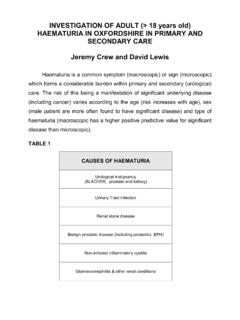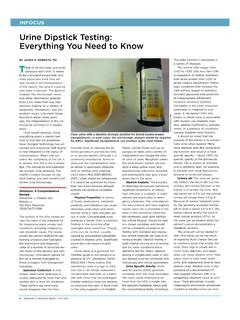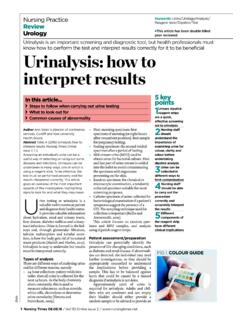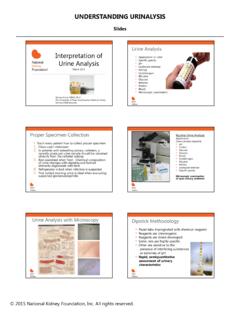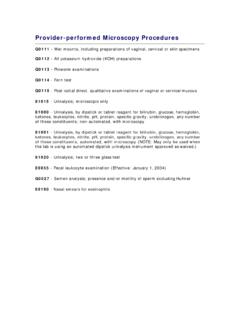Transcription of Urinalysis Interpretation - University of Wisconsin–Madison
1 Urinalysis InterpretationTyler Liebenstein, PharmDBackground EA and Prince RA. Urinary tract infections and prostatitis. In: DiPiro JT, Talbert RL, Yee GC, et al. Pharmacotherapy: A Pathophysiologic Approach. McGraw-Hill; 2011 GS and Brendler CB. Evaluation of the Urologic Patient: History, Physical Examination, and Urinalysis . In: Wein AJ, Kavoussi LR, Novick AC, et al. Campbell-Walsh Urology. Philadelphia, PA: Elsevier Saunders; 2011 A. Urine sampling and culture in the diagnosis of urinary tract infection in adults. Up To Date. Updated April 22, Describe which patients may benefit from a Urinalysis Define the components of a macroscopic, dipstick , and microscopic Urinalysis Interpret the results of a macroscopic, dipstick , and microscopic Urinalysis Identify the limitations of a urinalysisDefinition Urinalysis Physical, chemical, and microscopic examination of urine Involves many tests to detect and measure various compounds that pass through the urine Also used to detect the presence of an infection in the urinary tractWhy perform a Urinalysis ?
2 Symptoms of a urinary tract infection Painful urination Frequency Urgency Lower abdominal pain Flank pain Diagnosis of urologic conditions Elderly patients with unexplained delirium Unexplained feverMethods of sampling urine Clean-catch specimen Preferably first morning void, although this is usually not possible Patient should waste first 5 mL, then catch 5 10 mL mid-stream Antibacterial wipes Studies have not demonstrated consistent clinical benefit Catheter specimenMethods of chemical culture Identify specific organism causing infection (if any) Typically takes 1-3 days to resultMacroscopic Urinalysis Direct visual observation of urine Color Dark dehydration, rhabdomyolisis, liver disease Red tinge blood in the urine Other colors medications ( rifampin red/orange)
3 Clarity Hazy or cloudy infectionDipstick Introduction Plastic strip dipped in urine sample Test for various chemical components of urine Results in seconds to minutes Often performed in emergency departments or ambulatory clinics that do not have a micro lab available Associated with false negatives Use caution if a negative dipstick test results in a patient with symptoms of a UTI dipstick is specific, but not very sensitive Sensitivity related to bacterial load Perform a urine culture Tests Specific gravity, pH, leukocyte esterase, nitrites, hemoglobin, protein, glucose, ketones, urobilinogen, bilirubinDipstick Indicators of Infection pH Normal: 8 Alkaline urine in a patient with UTI suggests the presence of a urea-splitting organism (ex.)
4 Proteus) Some exceptions exist, such as Staphylococcus, Enterococcus, and Pseudomonas Leukocyte esterase Normal: negative Esterase released by White Blood Cells (WBCs) Nitrite Normal: negative Bacteria reduce dietary nitrates to nitrites Hemoglobin Normal: negative RBCs can enter urinary tract due to disease or traumaNon-infectious dipstick Tests Specific gravity Normal: Indication of hydration status Protein Normal: negative Positive result could indicate infection, diabetes, trauma Glucose Normal: negative Most glucose filtered by kidneys is reabsorbed Glucose may spill into urine if amount of glucose present exceeds kidney s capacity to reabsorb (uncontrolled diabetes)Non-infectious dipstick Tests (cont.
5 Ketones Normal: negative Product of body fat metabolism commonly associated with uncontrolled diabetes Urobilinogen Normal: mg/dL Excess concentrations can indicate liver damage ( , cirrhosis) or hemolytic anemia Bilirubin Normal: negative Can indicate liver disease or biliary obstructionMicroscopic Urinalysis Used to confirm and further define a positive dipstick Urinalysis Will provide quantity of bacteria Allows for eventual speciation and sensitivity testing to be completed, in order to guide therapy Often used in patients with: Recurrent infection Prior infection unresolved with antibiotics Signs/symptoms of an upper urinary tract infection Complicated UTIsMicroscopic Urinalysis (cont.)
6 WBC Normal: 0 5 per hpf Men usually have < 2/hpf; women usually have < 5/hpf Presence of elevated WBCs indicates the body may be fighting infection in the urinary tract RBC Normal: 0 1 per hpf Presence indicates damage to urinary tract ( , infection, physical trauma, etc.) Bacteria Normal: negative Presence of bacteria is not always predictive of a UTI (ex. asymptomatic bacteriuria, catheter colonization) Must use in conjunction with other factorsMicroscopic Urinalysis (cont.) Epithelial cells Squamous epithelial cells Normal: 0 2 per hpf Large numbers may indicate a poor sample (contamination) Renal epithelial cells Normal.
7 0 1 per hpf Large numbers may indicate renal tubular injury Crystals and casts Typically indicative of inflammation, infection, or injury in the urinary tractUrinalysis ExampleMisleading Aspects Squamous epithelial cells present May not be a clean-catch sample Elderly patients May have bacteria in urine without having an active infection Presence of urinary catheter Catheter may be colonized with bacteria (not a true infection) No single lab test result is sufficient to definitively indicate infection by itself Must interpret lab tests along with clinical pictureThank you!

